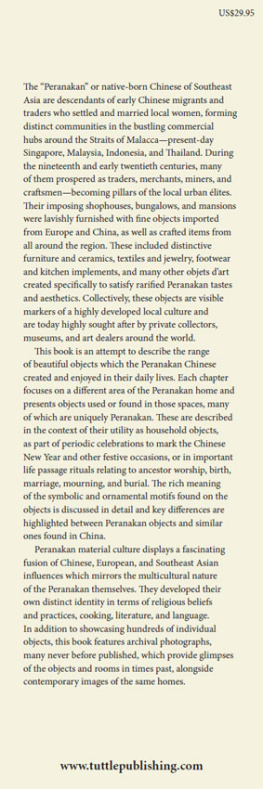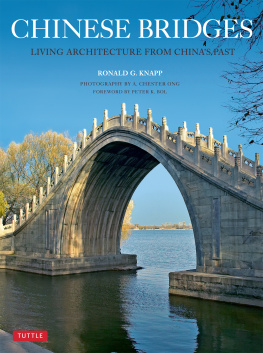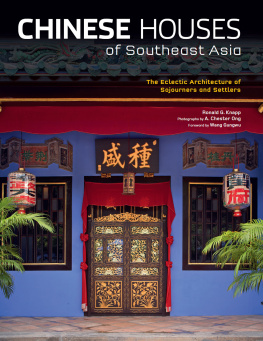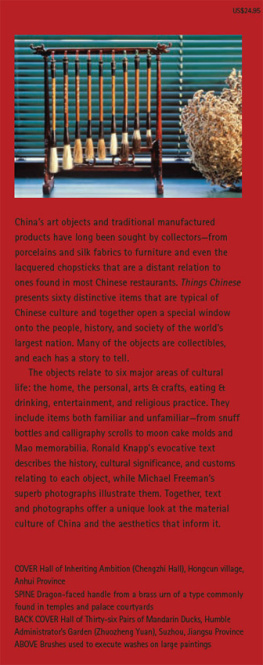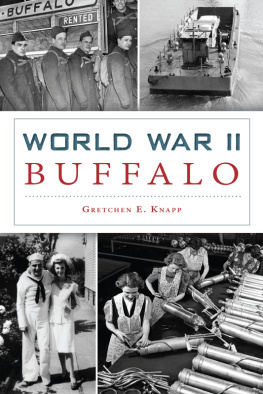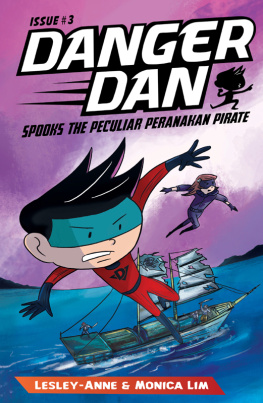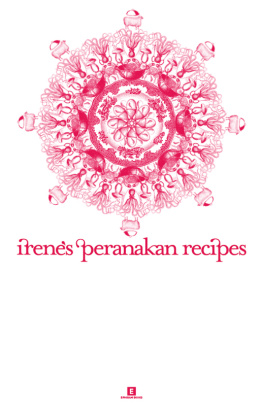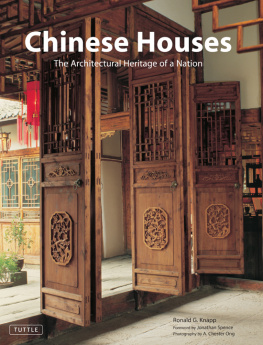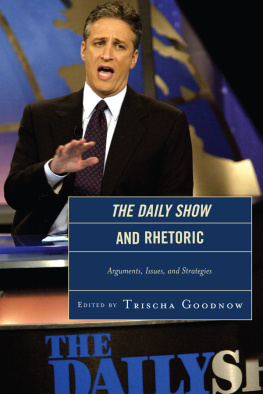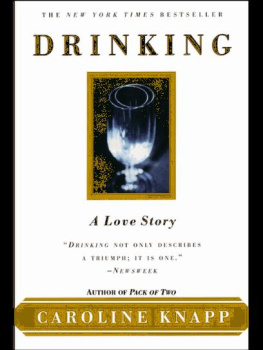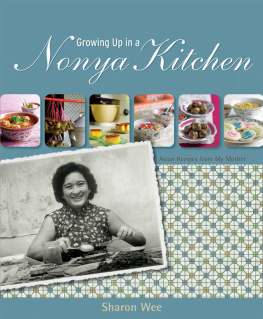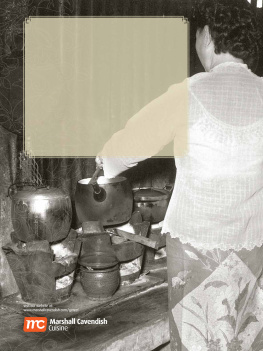Ronald G. Knapp - The Peranakan Chinese Home: Art and Culture in Daily Life
Here you can read online Ronald G. Knapp - The Peranakan Chinese Home: Art and Culture in Daily Life full text of the book (entire story) in english for free. Download pdf and epub, get meaning, cover and reviews about this ebook. year: 2013, publisher: Tuttle Publishing, genre: Home and family. Description of the work, (preface) as well as reviews are available. Best literature library LitArk.com created for fans of good reading and offers a wide selection of genres:
Romance novel
Science fiction
Adventure
Detective
Science
History
Home and family
Prose
Art
Politics
Computer
Non-fiction
Religion
Business
Children
Humor
Choose a favorite category and find really read worthwhile books. Enjoy immersion in the world of imagination, feel the emotions of the characters or learn something new for yourself, make an fascinating discovery.
- Book:The Peranakan Chinese Home: Art and Culture in Daily Life
- Author:
- Publisher:Tuttle Publishing
- Genre:
- Year:2013
- Rating:3 / 5
- Favourites:Add to favourites
- Your mark:
- 60
- 1
- 2
- 3
- 4
- 5
The Peranakan Chinese Home: Art and Culture in Daily Life: summary, description and annotation
We offer to read an annotation, description, summary or preface (depends on what the author of the book "The Peranakan Chinese Home: Art and Culture in Daily Life" wrote himself). If you haven't found the necessary information about the book — write in the comments, we will try to find it.
The Peranakan Chinese Home: Art and Culture in Daily Life — read online for free the complete book (whole text) full work
Below is the text of the book, divided by pages. System saving the place of the last page read, allows you to conveniently read the book "The Peranakan Chinese Home: Art and Culture in Daily Life" online for free, without having to search again every time where you left off. Put a bookmark, and you can go to the page where you finished reading at any time.
Font size:
Interval:
Bookmark:
ACKNOWLEDGMENTS
The writing of this book on Peranakan Chinese homes has been part of an intellectual journey that carried me from decades of field research in China to multiple field trips into unexplored territory in Southeast Asia that encompasses the extent of the Chinese diaspora. While researching our 2010 book, Chinese Houses of Southeast Asia , we found ourselves puzzling as to how to differentiate residences built and occupied by Peranakan Chinese from contemporaneous homes. It is our hope that The Peranakan Chinese Home will help clarify this. While this book in many ways resembles our 2010 book, a careful reader will see striking differences in both approach and scope of the narrative. The Peranakan Chinese Home takes an explicitly comparative approach, rather than the episodic house-by-house approach of our earlier book, in order to focus on generalizations that help illuminate similarities and differences.
Inspired by the organization of Peter Lee and Jennifer Chens fine 2006 book, The Straits Chinese House: Domestic Life and Traditions , which updated their 1998 book, Rumah Baba: Life in a Peranakan House , I decided to take a similar room-by-room view of Peranakan homes so that comparisons would be more explicit because of the juxtaposition of images and text. Moreover, this new book expands the geographic scope beyond Malacca, Singapore, and Penang to other areas occupied by Peranakan Chinese, especially Indonesia and Thailand.
Chinese Houses of Southeast Asia included a comprehensive Acknowledgments section (pp. 2814) that expresses our profound gratitude to a lengthy list of individuals and institutions who aided us. While many of these also were extremely helpful as we pursued this new book, some other homeowners and institutions were equally responsive as new questions were raised and new photographs were taken as we carried out additional field work.
I am indebted to those who read portions of the manuscript and offered criticisms and suggestions, especially Tan Chee-Beng, Peter Lee, Tan Siok Choo, and Patricia Bjaaland Welch. Whatever shortcomings remain are my own. We are especially grateful for the assistance of Director Alan Chong and Curator Jackie Yoong of The Peranakan Museum who generously made available twenty images of significant objects in their collection that add significantly to the architectural photography done by A. Chester Ong.
For permission to use photographs taken at their residences, museums, and archives, as well as those who helped us make contacts, we wish to thank the following:
Indonesia : Fon Prawira Tjong (Tjong A Fie Mansion); His Holiness Aryamaitri and Sutrisno Murtiyoso (Prasada Mandala Dharma); Robert Han (Han Family Ancestral Hall); Hartono Trisnohadi (Residence); Tan Tjoan Pie/P. W. B. Dharmowiyono (Residence); Ang Eng Hoat (Residence).
Malaysia : Tan Siok Choo (Tan Cheng Lock Ancestral Home); Dato Kee Phaik Cheen (Kee Family Manor); Loh-Lim Lin Lee and Laurence Loh (The Blue Mansion/Cheong Fatt Tze Mansion); Loh Joo Eng and Peter Soon (Pinang Peranakan Mansion); Cedric Tan (Residence); Chee Jin Siew (Residence); Khoo Salma Nasution (Sun Yat Sen Museum); Serge Jardin and K. C. Lee (Snail House); Betty Ong (Persatuan Peranakan Cina Melaka); and for wide-ranging liaison assistance, Josephine Chua and Colin Goh.
Singapore : Foo Soo Ling (National University of Singapore Baba House Museum); Johnson Tan (Residence); Alvin Yapp (Residence); Chan Tai Peo and Ou Eng Hwa (Nanyang Sacred Union); Asian Civilisations Museum; National Museum of Singapore; National Archives of Singapore.
Thailand : Poosak Posayachinda (Residence); Jaroonrat Tandavanitj (Chyn Pracha Mansion). In addition to the names above, a large number of anonymous individuals invited us into their homes to look around, talk, and take photographs, some of which appear in this book.

BIBLIOGRAPHY
Bartholomew, Terese Tse, Hidden Meanings in Chinese Art: Zhongguo Jixiang Tuan , San Francisco: Asian Art Museum of San Francisco, 2006.
Bickford, Maggie, The Symbolic Seasonal Round in House and Palace: Counting the Auspicious Nines in Traditional China, in Ronald G. Knapp and Kai-Yin Lo (eds.), House Home Family: Living and Being Chinese , Honolulu: University of Hawaii Press, 2005, pp. 34971.
Bird, Isabella L. [Mrs J. F. Bishop], The Golden Chersonese and the Way Thither , New York: G. P. Putnams Sons, 1883.
Bluss, Leonard, Batavia 16191740: The Rise and Fall of a Chinese Colonial Town, Journal of Southeast Asian Studies , 12(1), 1981, pp. 15978.
Burkhardt, V. R., Chinese Creeds & Customs , Hong Kong: South China Morning Post Ltd, 1953.
Cameron, John, Our Tropical Possessions in Malayan India: Being a Descriptive Account of Singapore, Penang, Province Wellesley and Malacca , London: Smith Elder and Co., 1865.
Campbell, Helen, Household Economics: A Course of Lectures Etc , New York: G. P. Putnams Sons, 1897.
Chang, Queeny, Memories of a Nonya , Singapore: Eastern Universities Press, 1981.
Chavannes, Edouard, The Five Happinesses: Symbolism in Chinese Popular Art , New York: Weatherhill, 1973.
Cheah Hwei Fen, Nyonya Beadwork and Contemporary Peranakan Chinese Culture in Singapore and Malaysia, in Marianne Hulsbosch, Elizabeth Bedford, and Martha Chaiklin (eds.), Asian Material Culture , Amsterdam: Amsterdam University Press, 2009, pp. 67102.
_____, Phoenix Rising: Narratives in Nyonya Beadwork from the Straits Settlements, 1870 to the Present, Ph.D. Dissertation, Australian National University, 2005.
Chee, Joan, Chang Yong Lee, and Vicki Kor, On the Trail of the Phoenix: The Homes of the Straits Chinese , Singapore: MediaCorp TV12, 2002.
Chia, Felix, The Babas , Singapore: Times Books International, 1980.
Chua Ai Lin, Modernity, Popular Culture and Urban Life: Anglophone Asians in Colonial Singapore 19201940, Ph.D. Dissertation, University of Cambridge, 2008.
Clammer, John R., Straits Chinese Society: Studies in the Sociology of the Baba Communities of Malaysia and Singapore , Singapore: Singapore University Press, 1980.
Davison, Julian, Singapore Shophouse , Singapore: Talisman, 2010.
Day, Clarence B., Chinese Peasant Cults: Being a Study of Chinese Paper Gods , Shanghai: Kelly & Walsh, 1940.
Dhoraisingam, Samuel, Peranakan Indians of Singapore and Melaka: Indian Babas and NonyasChitty Melaka , Local History and Memoirs No. 14, Singapore: Institute of Southeast Asian studies, 2006.
Edwards, Norman, The Singapore House and Residential Life 18191939 , Singapore: Oxford University Press, 1990.
Ee, Randall, et al., Peranakan Museum: AZ Guide , Singapore: Asian Civilisations Museum for the Peranakan Museum, 2008.
Frost, Mark Ravinder, Emporium in Imperio: Nanyang Networks and the Straits Chinese in Singapore, 18191914, Journal of Southeast Asian Studies , 36(1), 2005, pp. 2966.
_____, Transcultural Diaspora: The Straits Chinese in Singapore 18191918 , ARI working papers series No. 10, Singapore: Asia Research Institute, 2003; http://www.ari.nus.edu.sg/pub/wps2003/abs010.htm.
Gwee Thian Hock, William, Preface, in Jurgen Rudolph, Reconstructing Identities: A Social History of the Babas in Singapore , Singapore: Ashgate, 1998.
Handler, Sarah, Austere Luminosity of Chinese Classical Furniture , Berkeley: University of California Press, 2001.
Hardwick, Patricia Ann, Neither Fish Nor Fowl: Constructing Peranakan Identity in Colonial and Post-Colonial Singapore, Folklore Forum , 38(1), 2008, pp. 3655.
Heidhues, Mary F. Somers, Southeast Asias Chinese Minorities , Hawthorn, Victoria, Australia: Longman, 1974.
Font size:
Interval:
Bookmark:
Similar books «The Peranakan Chinese Home: Art and Culture in Daily Life»
Look at similar books to The Peranakan Chinese Home: Art and Culture in Daily Life. We have selected literature similar in name and meaning in the hope of providing readers with more options to find new, interesting, not yet read works.
Discussion, reviews of the book The Peranakan Chinese Home: Art and Culture in Daily Life and just readers' own opinions. Leave your comments, write what you think about the work, its meaning or the main characters. Specify what exactly you liked and what you didn't like, and why you think so.

